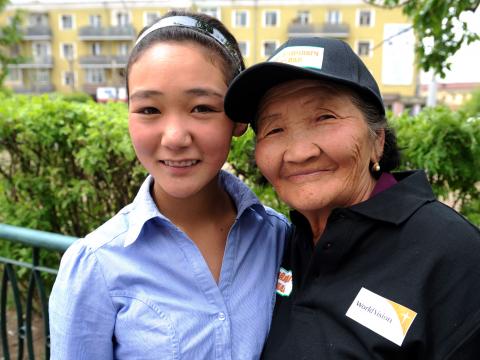Trading pigeon feed for vocational classes

Turning up at the monastery with one goal in mind, to pray for her poverty-stricken family, Anara left with another.
Approaching the religious hub, the then 10-year-old was stopped by an elderly woman, who asked her to buy some rice from a nearby grocery store. Seeing Anara, as she is known, return with a one-kilo bag, the woman had one more request: to pour the contents into ten small packets.
I had to skip school to work.
Loitering on the streets, the woman sold rice to monastery-goers, whose going-through-the-motions good deed was to feed the pigeons. Her good deeds done, Anara said goodbye knowing she would return to sell rice to help her jobless father.
“I used to get up at nine in the morning and go straight to the monastery to sell rice,” explains Anara, who is now 15 years old. “My classes started at one in the afternoon, so I went in the mornings.”
“At weekends, I worked the whole day, making two to three [US] dollars,” she continues. “And when I badly needed money, I had to skip school to work.”
Anara’s mother died when the girl was young, while her alcoholic father remained unemployed and neglected his two daughters. A World Vision home visitor, Norjin, met the family two years ago in their aging ‘ger’, Mongolia’s traditional shelter, which had no sink, bedsheets or proper floor.
Norjin says, “Anara’s father had no identification documents, which are essential to get a job or social welfare. So I helped get the documents and World Vision immediately gave them food and clothes.”
Low household incomes and neglect are the main reasons for childhood work in Mongolia. Child labour is cheap and adults refuse to accept the same meagre wages, preferring to rely on state handouts.
Almost 16 percent of Mongolian children ages six to 17 are involved in child labour, a figure which equates to nearly 94,000 individuals, according to the government’s National Authority for Children in 2014.
World Vision’s home visitors identify and monitor children at risk of abuse, neglect and child labour.
Speaking with the website mass.mn last year, the head of the state body’s department responsible for child development, Baavgai H, revealed, “Compared to statistics from 2006, the number of child labour cases has increased, which means legislation regulating the involvement of children in labour is not working on the ground.”
To deal with this, World Vision’s home visitors identify and monitor children at risk of abuse, neglect and child labour. Today, nearly 170 trained home visitors work in 20 Mongolian communities, monitoring a total of 935 vulnerable children twice a month.
Norjin says, “After visiting Anara’s family several times, we became closer. We were like a family. Anara’s father was more open and responsible. He started drinking less and looking for a job.
“He’s now doing construction work to make a living and Anara has stopped working. I’m happiest when I see families smiling and their lives getting better.”
This year was the turning point for Anara, who has begun a vocational course to be a chef. She says: “I’m in my first year, so I’m learning the basics of cooking, like dough and chopping. But next year, I’ll learn how to make lots of complicated dishes.”
Excited to be studying a useful skill, Anara now dreams of opening her own restaurant. She’s on the right path.